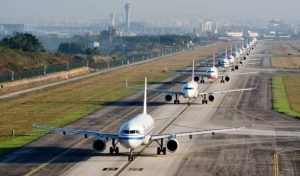UK News
UK Air Traffic Control Glitch Sparks Warnings of Flight Delays

It’s been quite a rollercoaster for air passengers in the UK. A “technical issue” played havoc with air traffic control systems, causing major delays and even flight cancellations. National Air Traffic Services stepped in, but the aftermath is far from over.
UK air traffic control failure
Despite fixing the issue, airlines and airports are grappling with the fallout. Imagine being stuck at the airport until midnight, like one passenger shared with BBC News. And don’t expect a quick fix – the disruption might linger for days.
Heathrow’s schedule remains tangled, while Gatwick aims for normalcy but advises caution. London Luton Airport is singing the same tune, urging passengers to check their flights. NATS confessed and fixed the fault, but they caution that it might take a while for flights to return to normal.
Stay patient, keep an eye on your flight, and hopefully, smoother skies are ahead. Safe travels, everyone! ✈️
What is the air traffic service?

The air traffic service (ATS) ensures safe and efficient movement of aeroplanes in controlled airspace and airports. UK air traffic control organisations like NATS (National Air Traffic Services) and their international counterparts provide these services.
Air traffic services include numerous key components:
- Air Traffic Control (ATC): ATC controls aircraft on the ground and in controlled airspace. ATC controllers train pilots, guide aircraft during takeoff and landing, and maintain flight separation.
- Air traffic flow management (ATFM): Air traffic management (ATFM) prevents congestion and delays. This service balances airspace demand and capacity based on weather, airport capacity, and routes.
- Air traffic advisory services: These services advise pilots about weather, dangers, and other flight-related issues. These advisories help pilots make safe flight decisions.
- Air Traffic Information Services (ATIS): Pilots receive current airport data including weather, runway usage, and more from ATIS. This information helps pilots land or depart.
- Flight Information Services (FIS): FIS provides airspace, navigation, and other flight information to pilots. This is especially useful for pilots in uncontrolled airspace.
- Alerting Services: Alerting services activate search and rescue efforts in crises.
- Air Traffic Services Units: These units provide air traffic services, including ATC, to minor airports or regions. They operate in low-traffic locations.
- Crash Avoidance Systems: TCAS (Traffic Collision Avoidance System) helps aircraft avoid collisions without human controls.
Air traffic services are essential to aviation safety, order, and efficiency. These services help aircraft navigate and operate at airports while minimising crashes and maximising airspace and infrastructure.
Who runs air traffic control UK?
In the UK, the management of air traffic control is primarily handled by NATS (National Air Traffic Services).
NATS, which stands for National Air Traffic Services, is a company that has been established by the government. Its main responsibility is to provide air traffic control services and effectively manage the airspace over the United Kingdom.
The organisation is responsible for managing control centres, radar installations, communication systems, and other technological infrastructure. Its main goal is to ensure the safe and efficient movement of aircraft within the airspace of the United Kingdom.
NATS also collaborates closely with international partners to ensure smooth coordination of flights that enter or exit UK airspace.
What are the benefits of air traffic control?
Air traffic control (ATC) provides crucial safety and efficiency benefits to the aviation industry by ensuring aircraft separation, preventing collisions, and guiding pilots through safe flight paths.
Through efficient airspace management, congestion reduction, weather guidance, and real-time communication, ATC enhances the overall safety of air travel, optimizes flight operations, and supports timely decision-making for pilots, contributing to the smooth functioning of air traffic even in complex and challenging conditions.











